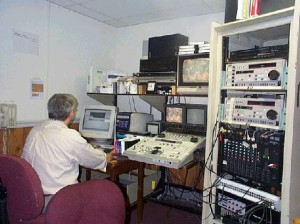
Production
The hard part is done – you’ve planned out what you want, you’ve gathered your materials, you’re ready to film and edit!
It’s in the director’s hands now. He or she should make sure everyone understands how the program should be shot.
Shooting Tips
Live Productions
Live productions are very fast-paced. Once they start, there’s no stopping them. Plan to set up and TEST your equipment about an hour before the event starts. If you plan to use graphics or titles while filming live, make sure all words and names are spelled correctly, in the right order, and show up on the screen properly.
If you’re filming a large event, like a fair, it’s better to send out several camera crews to cover all the different activities.
Studio Productions
Whether you’re on a set or filming in different locations, you have a lot more leeway for creativity and correction. Did the talent goof their intro? Just keep the film rolling, have them pause, and the try again. Want to switch to a different angle? Again, stop the activity and make your changes. You can film things out of order, or even on different days.
Keep the filming straightforward. Don’t try to get into fancy fades or elaborate transitions. These can be added later.
Video Editing
 Once your raw footage is in the hands of the editor, the final process begins. The editor can cut out the bad scenes, rearrange footage into the proper order, make some alterations to correct video colors and raise or lower the audio to an extent. Titles can be created, transitions added, and music inserted.
Once your raw footage is in the hands of the editor, the final process begins. The editor can cut out the bad scenes, rearrange footage into the proper order, make some alterations to correct video colors and raise or lower the audio to an extent. Titles can be created, transitions added, and music inserted.
Thanks to technology, video editing can be done on the home computer by everyone! HCTV uses a Non-Linear editing system to create its programs.
A Few Handy Tips
Much of this was learned the hard way – remember HCTV is not run by professionals!
- Arrive early.
- Check your batteries.
- Replace them anyway.
- Allow plenty of time for filming.
- Test all equipment before filming begins.
- Be sure everything is set up properly and securely. Watching a camera fall over during filming is very unpleasant!
- Make sure you and your crew know how everything works. If you need to, have everyone meet a few days before filming and have a training session
- Feed the camera crew. Trust me on this.
- Have backups ready – of everything, including an alternate shooting location.
- For many shows, you do NOT need to shoot everything on the same day! Shooting your B-roll on a different day from your main footage can save you time and energy.
- Keep your filming simple. Fades, transitions, graphics, etc can all be added in post production.
- Again – film more than you think you’ll need!
- Being on camera can be nerve wracking. Give your talent time to relax and time to rehearse.
- If your talent makes a mistake, pause and allow them to start again. You may not need to begin the entire shoot over. Simply allow a pause in the tape, and then pick up a sentence or a paragraph before the mistake was made. The error can be cut out in post production.
- Don’t wear blue or purple if you’re going to be standing in front of a bluescreen.
- Red tends to bleed on film. Avoid wearing bright reds or using them in graphics.
- Talent should look directly into the camera lens when addressing the audience. If talent is interviewing a guest, they should both avoid looking at the camera, except when the host is giving introductions or instructions to the audience.

